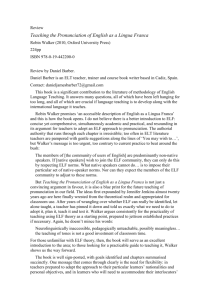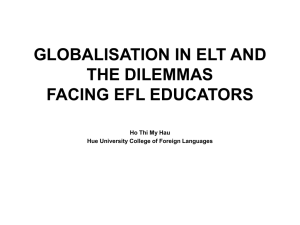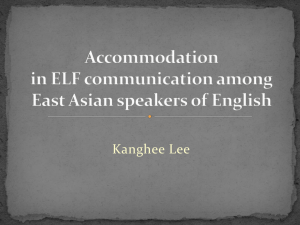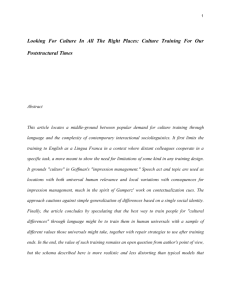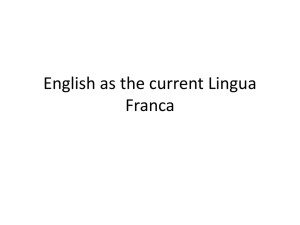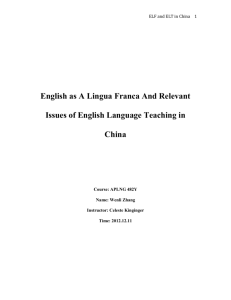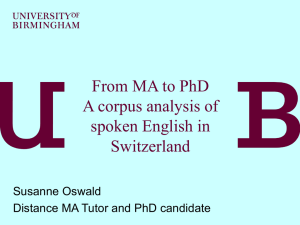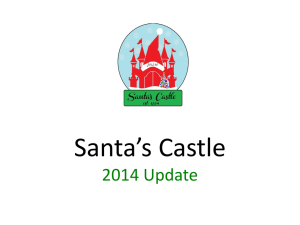English as a Lingua Franca
advertisement
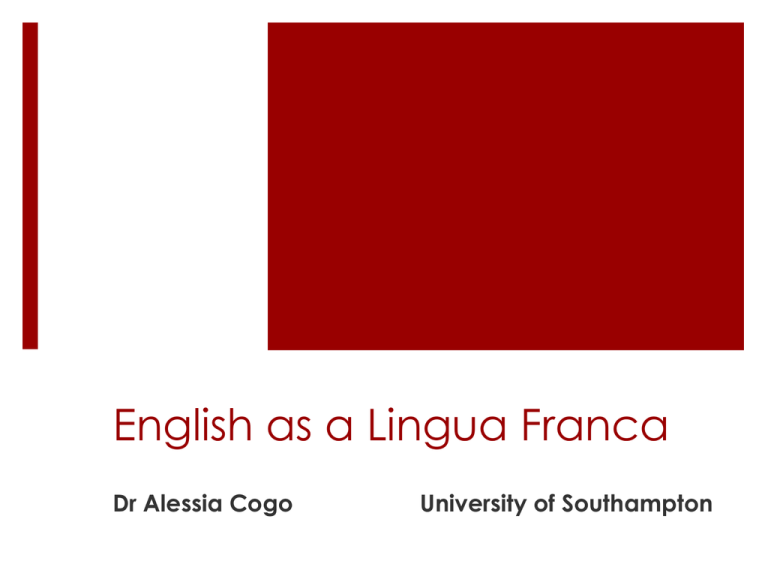
English as a Lingua Franca Dr Alessia Cogo University of Southampton In this session We conceptualize the spread of English in the world (Kachru’s model) We explore the phenomenon of English as a Lingua Franca Kachru’s model Kachru (1992: 356) Most useful and influential model World Englishes divided into three concentric circles: 1 Inner Circle: ENL countries, ‘norm-providing’ 2 Outer Circle: ESL countries, ‘norm-developing’ 3 Expanding Circle: EFL countries, ‘normdependent’ Speakers of English as a Lingua Franca (ELF) It has been estimated (conservatively) that there are as many as 2 billion speakers of English as a second language or lingua franca worldwide today. (Crystal, 2008) What is ELF? ELF constitutes a common means of communication for speakers of different first languages. ELF is currently the most common use of English world-wide. Millions of speakers from diverse cultural and linguistic backgrounds use ELF on a daily basis, routinely and successfully, in their professional, academic and personal lives. www.univie.ac.at/voice ELF speakers Gnutzmann (2000:358) ‘when used as a lingua franca English is no longer founded on the linguistic and sociocultural norms of native English speakers and their respective countries and cultures’ ELF speakers are multilingual speakers and they draw on their multilingual repertoire in ELF communication Therefore it is the multilingual context which is key for understanding and researching ELF. ELF speakers ELF speakers = multilingual speakers intercultural speakers: ‘one might consider their performance as a “third way”, a crossing of borders, as a sign of a hybrid culture in operation’ (House 2007:17) ‘third spaces offer opportunities to be creative’ (Kelly 2009:15) Symbolic competence: “Social actors in multilingual settings […] seem to display a particularly acute ability to play with various linguistic codes and with the various spatial and temporal resonances of these codes” (Kramsch & Whiteside 2008:664). ELF: what it is ELF as a useful medium of communication ELF is not dependent on the norms of the inner circle countries ELF is not necessarily geographically located ACTIVITY Discuss your experience of English as a Lingua Franca. Have you ever experienced communication with other non-native speakers of English? Where? Who were the people involved? What have you noticed about the way they speak? ELF: pronunciation Different accents used in ELF general attitude of acceptance of difference phenomenon of ACCOMMODATION ELF: lexico-grammar use of third person present tense -0 interchangeability of the relative pronouns who and which interchangeability of definite and indefinite articles Different use of prepositions eg. Study about / discuss about ELF: pragmatics Increase expliciteness Use of translation strategies Use of multilingual resources Use of repetition and paraphrasing Resources: Reading to get you started… Cogo, A. 2010. Strategic use and perceptions of English as a Lingua Franca. Poznań Studies in Contemporary Linguistics. 46/3: 295-312. Available online at Versitas. Seidlhofer, B. 2005. “English as a lingua franca.” ELT Journal 59: 4, 339-340. Freely available online on ELTJ website. Others: Jenkins, J. 2007. English as a Lingua Franca: Attitudes and Identity. Oxford: Oxford University Press. Seidlhofer, B. 2011. Understanding English as a Lingua Franca. Oxford: Oxford University Press. Mauranen, A.; Ranta, E. (Eds.). 2009. English as a lingua franca: Studies and findings. Newcastle upon Tyne: Cambridge Scholars Publishing. Resources: Archibald, A.; Cogo, A.; Jenkins, J. (Eds.). 2011. Latest trends in ELF research. Newcastle on Tyne: Cambridge Scholars Publishing. Jenkins, J., Cogo, A. and Dewey, M. 2011. Review of developments in research into English as a lingua franca. Language Teaching, 44.3, 281–315 Websites: ELFA website. http://www.helsinki.fi/englanti/elfa/elfacorpus.ht ml. CGE website www.southampton.ac.uk/cge/ VOICE website. www.univie.ac.at/voice


